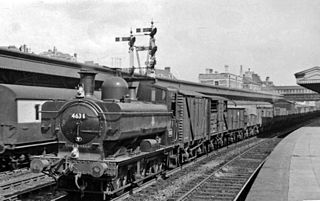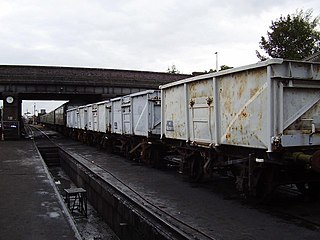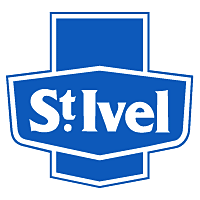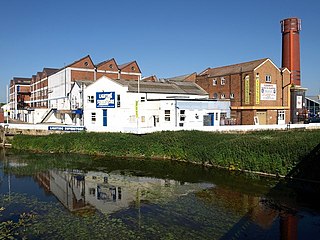
The London, Midland and Scottish Railway (LMS) was a British railway company. It was formed on 1 January 1923 under the Railways Act of 1921, which required the grouping of over 120 separate railways into four. The companies merged into the LMS included the London and North Western Railway, Midland Railway, the Lancashire and Yorkshire Railway, several Scottish railway companies, and numerous other, smaller ventures.

Brake van and guard's van are terms used mainly in the UK, Ireland, Australia and India for a railway vehicle equipped with a hand brake which can be applied by the guard. The equivalent North American term is caboose, but a British brake van and a caboose are very different in appearance, because the former usually has only four wheels, while the latter usually has bogies. German railways employed Brakeman's cabins combined into other cars.
The Leek and Manifold Valley Light Railway (L&MVLR) was a narrow gauge railway in Staffordshire, England that operated between 1904 and 1934. The line mainly carried milk from dairies in the region, acting as a feeder to the 4 ft 8+1⁄2 instandard gauge system. It also provided passenger services to the small villages and beauty spots along its route. The line was built to a 2 ft 6 in narrow gauge and to the light rail standards provided by the Light Railways Act 1896 to reduce construction costs.

The steam locomotives of British Railways were used by British Railways over the period 1948–1968. The vast majority of these were inherited from its four constituent companies, the "Big Four".

The GWR 5700 Class, or 57xx class, is a class of 0-6-0 pannier tank steam locomotive, built by the Great Western Railway (GWR) and British Railways (BR) between 1929 and 1950. With 863 built, they were the most prolific class of the GWR, and one of the most numerous classes of British steam locomotive.

The Great Western Railway (GWR) 2251 Class or Collett Goods Class was a class of 0-6-0 steam tender locomotives designed for medium-powered freight. They were introduced in 1930 as a replacement for the earlier Dean Goods 0-6-0s and were built up to 1948.
The Charfield railway disaster was a fatal train crash which occurred on 13 October 1928 in the village of Charfield in the English county of Gloucestershire. The Leeds to Bristol London, Midland and Scottish Railway (LMS) night mail train failed to stop at the signals protecting the down refuge siding at Charfield railway station. The weather was misty, but there was not a sufficiently thick fog for the signalman at Charfield to employ fog signalmen. A freight train was in the process of being shunted from the down main line to the siding, and another train of empty goods wagons was passing through the station from the Bristol (up) direction.

A mineral wagon or coal truck is a small open-topped railway goods wagon used in the United Kingdom and elsewhere to carry coal, ores and other mine products.
Uniq plc was a British food manufacturer. Listed on the London Stock Exchange and once a constituent of the FTSE 100 Index, it was taken over by Irish foods conglomerate Greencore in 2011.
The history of rail transport in Great Britain 1923–1947 covers the period when the British railway system was run by the Big Four group of companies – the London, Midland and Scottish Railway (LMS); the Great Western Railway (GWR); the London and North Eastern Railway (LNER); and the Southern Railway (SR). The period includes the investment following World War I; the rise in competition from the roads in the 1920s; development of steam locomotives capable of sustained 100 mph (160 km/h) running; the Great Depression of the 1930s; World War II and its aftermath; and the lead up to nationalisation during 1947.

St Ivel is a brand of dairy products in the United Kingdom, introduced in 1901 by the Yeovil-based dairy company Aplin & Barrett, for use on a range of their products.

United Dairies is a former United Kingdom-based creamery, milk bottling and distribution company. The company was formed in 1915 and merged to form Unigate in 1959.

The fleet of Great Western Railway wagons was both large and varied as it carried the wide variety of goods traffic on the Great Western Railway (GWR) in the United Kingdom. This was the railway company that operated for the longest period of time in the country and covered a large geographical area that included big cities such as London, industrialised areas including the West Midlands, areas of coal and mineral mining such as South Wales, and Somerset and other important agricultural districts. In 1902 the company owned 59,036 wagons, and by 1926 this had risen to 88,580.

From 1920, the cab side of Great Western Railway (GWR) steam locomotives bore a letter on a coloured disc, which enabled staff to quickly assess the capabilities of locomotives without the need to check tables of data. The letter showed the power classification, and the coloured disc showed the weight restriction. This system continued after the GWR became the Western Region of British Railways.

The GWR Toad is a class of railway brake van, designed by and built for the Great Western Railway. Used by the GWR from 1894, and post-1947 by the Western Region of British Railways, its role was a safety brake on goods trains in the West of England, the Midlands and Wales.

The GWR Siphon was a series of enclosed milk churn transport wagons built by the Great Western Railway and continued by British Railways.

Milk trains were a common sight on the railways of Great Britain from the early 1930s to the late 1960s. Introduced to transport drinking milk from creameries to consumers in the cities, by 1981 they had all been replaced by road transport.

A bruck is a type of bus or coach built to combine goods and passenger transport where it is most profitable or most convenient compared to separate vehicles. The word bruck was used in North America. In Australia they were known as passenger-freighters. In Europe they are known as Kombinationsbus (German), seka-auto (Finnish), kombibuss (Norwegian) and godsbuss (Swedish), with even the nickname skvader. They have for practical reasons mostly been built on front- or mid-engined chassis. In North America and Australia this type of bus was introduced in the late 1940s as a replacement for unprofitable railway lines, while in Europe they have been around since the first buses.

Midland Electric Vehicles was a British manufacturer of milk floats and other battery electric road vehicles between 1936 and 1958. They were based in Leamington Spa, and one of their major customers was Midland Counties Dairies, to whom they supplied just the chassis, with bodywork being built by the customer. At least two of their vehicles survive in museums.

British Railways inherited a variety of brake vans from each of the Big Four: GWR, LNER, Southern Railway and LMS due to the nationalisation of the railways in 1948.




















